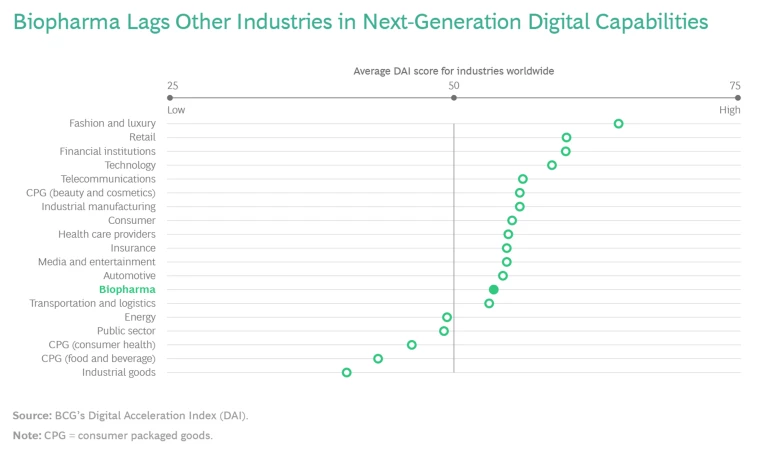Biopharmaceutical companies are vigorously investing in advanced analytics and machine learning to improve their interactions with their physician customers, deepen those relationships, and drive incremental sales. Yet the biopharma industry has fallen behind other industries in the race to develop digitally based, next-generation selling capabilities.
It’s commonly believed that the highly regulated and compliance-oriented nature of the health care industry is to blame for adhering to outdated sales models. But we’ve seen that internal resistance to change—particularly within the sales force—is the real culprit.
Commercial leaders and sales representatives are reluctant to tinker with a sales model that has worked effectively for decades. Commercial leaders at all levels have concerns about whether they will achieve their sales goals if reps are distracted or if experiments don’t succeed. And sales reps see such experiments as encroaching on their autonomy to sell; some even view technology as looming competition for their jobs.
There are five actions that biopharma companies can take to implement change management, overcome resistance in their ranks, and develop digitally based, next-generation selling capabilities that have the potential to put the industry on a par with others. (See the exhibit.)
Cocreate the Experiments with Field Teams
All too often, next-generation sales experiments are conducted in some hidden corner of headquarters and then rolled out to a few regions. Because these offices were not part of the experiment, this approach generates suspicion from the start. The rumor mill soon takes over, and suddenly reps (and their managers) start believing that headquarters does not think that they know how to do their jobs or that Big Brother is watching.
Field teams must be engaged from the very beginning to prevent this from happening. Reps and field managers need to be actively involved in cocreating the experiments in a way that makes the most of their years of experience. Discussion groups should be formed to answer various questions, including: What selling situations would benefit most from advanced analytics? Which customers should we focus on? What types of alerts would you want to receive about your customers? And what triggers should we be screening for? By defining hypotheses for which next-best actions would be most valuable, and by positioning advanced analytics and machine learning as useful tools for the field team, the sales organization can prepare the ground for a fertile experiment.
To train field teams, the most progressive biopharma companies use a test-and-learn approach.
To train field teams, the most progressive biopharma companies use a test-and-learn approach. Unlike the succeed-or-fail pilots used in the past, test-and-learn approaches do not presume the experiment will produce a positive return on investment or sales outcome. Instead, they focus on making incremental changes on a regular basis, taking into account that results could be affected by unanticipated factors.
Visibly Reinforce Sales Reps’ Autonomy
Reps’ biggest fear is that new technology will make them even more scripted than they already are. As it is, many companies dictate which doctors to visit and how often, and they drill their reps on the precise messages to convey through a host of internal training channels. Reps long for the level of autonomy that their counterparts in other industries have.
However, biopharma sales reps are accustomed to using technology to make decisions. They are accustomed to a world where apps sift through a lot of data and make recommendations. So for reps who are inundated with data, new technology needs to be presented as a tool that cuts through the noise and aids decision making—not a tool that dictates what to do next. The minute headquarters starts measuring reps on how closely they follow the next-best action, the battle for reps’ hearts and minds will be lost.
Get the Buy-In of First-Line Managers
Regardless of what top sales management espouses, the perspective of the first-line leaders—their advocacy for a new idea, their coaching of the reps on how to use it to drive sales performance, and their steadfast enforcement of accountability—determines whether the sales reps will ultimately adopt the change or not.
The perspective of the first-line leaders determines whether the sales reps will ultimately adopt the change or not.
So, it’s key to find out if the first-line managers want to adopt the technology and whether they’re able to instruct others on how to use it. For instance, some managers may think that next-best-action systems undermine their coaching, while others who are less comfortable with technology may find next-generation models expose their sense of inadequacy. If first-line leaders don’t embrace the new technology, it may not be adopted by enough sales reps to be successful.
Protect Sales Leadership from Downside Risk
With few exceptions, commercial and sales leaders have quarterly goals. In many compensation systems, even a small miss can limit compensation and career opportunities. This has led some sales organizations to believe that a next-generation pilot that involves even one out of ten reps or doctors poses too big a risk, despite the potential upside that it provides.
For this reason, biopharma sales organizations should take steps to protect leaders against downside risk, while simultaneously giving them credit for the upside. Tactically speaking, this means guaranteeing leaders 100% of their goal for the portion of their sales team or customer base that participates in the pilot. If the outcome is 110% or 120% (which it could well be), the leaders get credit for that, too. The same arrangement can be used with reps as well. Once leaders and reps see how new models can improve sales, they’ll be more likely to adopt them.
Actively Watch for and Address Cultural Barriers
Inevitably, challenges that are deeply embedded in a company's culture can get in the way of implementing change management and next-generation experiments. For example, a culture with an intense focus on reach-and-frequency tactics may encounter resistance to systems that ask for more creativity in driving the business. Alternatively, if there’s an underlying distrust of senior management, it can manifest itself as resistance to a next-generation program. In such situations, the people involved in driving the next-generation model may just see friction, not the underlying issue.
Test-and-learn experiments are an excellent way to address such cultural barriers. We recommend that a member of the experiment design team be designated as the culture captain to actively monitor for these situations. Whenever resistance arises, the culture captain should engage with the participants to uncover its root causes. Rapid experimentation may involve changes to the experiment’s design. Likewise, the implicit incentives that influence behavior should also be changed, such as the rewards for using the new models or reprimands for not. That way, any cultural barriers can be addressed before the experiment is scaled up.
In the years ahead, biopharma organizations must find ways to make next-generation selling more appealing to their sales organizations. By taking the right steps to bring the sales organization along for the journey, biopharma can achieve the levels of next-generation selling capability that are propelling other industries forward.







